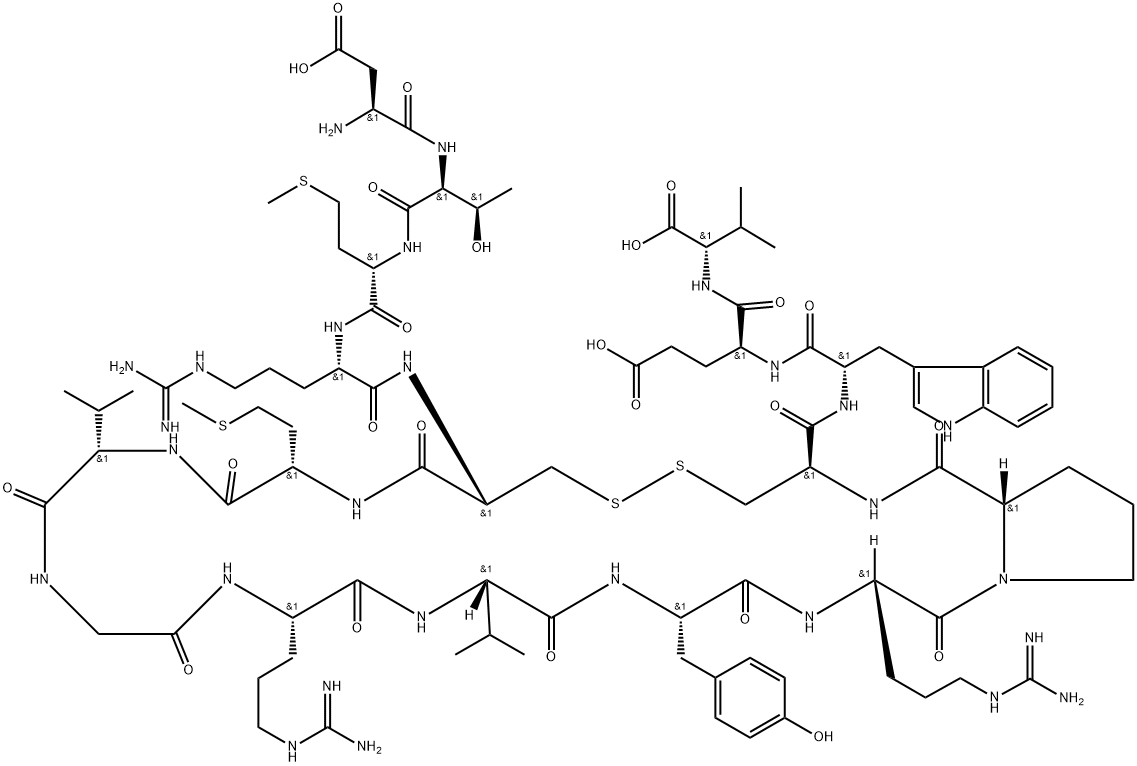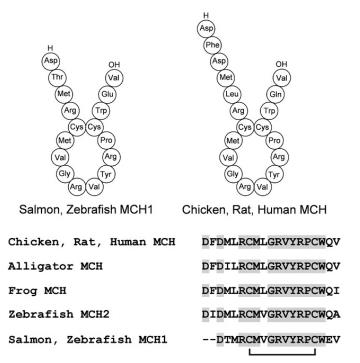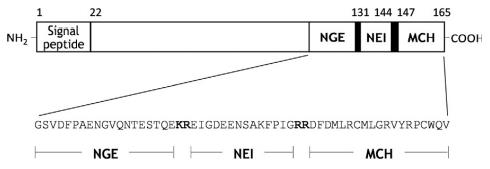
MELANIN CONCENTRATING HORMONE, SALMON
- Product NameMELANIN CONCENTRATING HORMONE, SALMON
- CAS87218-84-6
- CBNumberCB1314540
- MFC89H139N27O24S4
- MW2099.5
- MDL NumberMFCD00080194
- MOL File87218-84-6.mol
- MSDS FileSDS
Chemical Properties
| Density | 1.52±0.1 g/cm3(Predicted) |
| storage temp. | −20°C |
| solubility | Soluble in DMSO |
| form | Solid |
| color | White to off-white |
Safety
| Safety Statements | 22-24/25 |
| WGK Germany | 3 |
MELANIN CONCENTRATING HORMONE, SALMON Price
| Product number | Packaging | Price | Product description | Buy |
|---|---|---|---|---|
| Alfa Aesar J66264 | 0.5mg | $181 | Melanin Concentrating Hormone, salmon |
Buy |
| Alfa Aesar J66264 | 1mg | $282 | Melanin Concentrating Hormone, salmon |
Buy |
| Usbiological M2867-76E | 1mg | $450 | Melanin Concentrating Hormone |
Buy |
| Usbiological M2867-76H | 1mg | $531 | Melanin Concentrating Hormone |
Buy |
| Usbiological M2867-76F | 1mg | $276 | Melanin Concentrating Hormone |
Buy |
MELANIN CONCENTRATING HORMONE, SALMON Chemical Properties,Usage,Production
Discovery
It was realized in 1928 that the administration of teleost pituitary gland extract led to concentrated pigment in fish scales. In 1983, Kawauchi purified and sequenced the factor, named melanin-concentrating hormone (MCH), for the first time from the salmon pituitary. In mammals, the primary structure of rat MCH was determined by purification methods in 1989, and that of the human was determined from the cDNA sequence in 1990.Structure
Human proMCH consists of 165 aa residues with mature MCH at the C-terminus. Mature MCH is cleaved at the KR sequence either by prohormone convertase PC1/3 or PC2. MCH is a cyclic peptide formed by a disulfide bridge, and comprises 19 aa residues in tetrapods and 17 aa residues (MCH1) or 19–25 aa residues (MCH2) in teleost fish. The primary structure is well conserved; human MCH is identical to that of rodents and is highly similar to that of teleost fish. The central ring sequence between two cysteines is the most significant factor for melanin concentrating activity. Mr 2386.8; pI >9.5 (mouse, rat, human MCH). MCH is freely soluble in water, ethanol, and 70% acetone; insoluble in acetone, benzene, chloroform, and ether.

Gene, mRNA, and precursor
The human MCH gene (PMCH), located on chromosome 12 (12q 23-q24), consists of three exons.3 Exon 2 encodes neuropeptide G-E (NGE) and neuropeptide E-I (NEI), and exons 2 and 3 encode MCH. Two variant PMCH genes are also identified on 5p14 (PMCHL1) and 5q12-q13 (PMCHL2), but only a single locus is found in the rodent species. Teleost MCH2 is the ortholog of mammalian MCH, and MCH1 is a highly conserved paralog of MCH2. The MCH2 gene might be silent in some teleost fish such as salmonids.Synthesis and release
In rodents, MCH neurons receive projections from many brain areas and become active during REM sleep and novel object exploration. Neurotransmitters such as GABA, serotonin, acetylcholine, noradrenaline, dopamine, and neuropeptide Y all inhibit the MCH neurons. The firing of orexin neurons also inhibits MCH neurons via microcircuits. The metabolic factors glucose and insulin can enhance MCH neuronal activity, although glucose exerts the opposite effect on the orexin neurons. MCH may be coreleased with glutamate, GABA, or other neuropeptides and act synergistically. The activation of hypothalamic MCH neuron terminals reduced the firing of hippocampal pyramidal neurons by increasing the inhibitory inputs.Receptors
MCH acts via two G protein-coupled receptors, MCHR1 and MCHR2, of which functional MCHR2 is not present in rodents. MCHR1 is a glycoprotein consisting of 353 aa residues in the rat/human and maps to chromosome 22, q13.3 in humans. MCH binds to rat and human MCHR1s with Kd values of 1.6 and 0.5 nM, respectively. Strong labeling of MCHR1 mRNA is detected in several limbic structures and anatomical areas implicated in the control of olfaction in rats. MCHR1 is observed to be selectively targeted to a hair-like organelle named the primary cilium on the rodent and human neuronal cell. Human MCHR2 is also highly expressed in the brain.Signal transduction pathway
In recombinant cell lines, rat, mouse, and human MCHR1s are promiscuous, and couple to various GTP binding proteins such as Gi, Go, and Gq proteins. In contrast to human MCHR1, however, human MCHR2 exclusively couples to the Gq protein.Biological functions
The transgenic mice overexpressing the MCH gene are obese and insulin-resistant. Mice lacking the MCH gene are hypophagic, hyperactive, and lean. The MCH gene is upregulated in the leptin-deficient ob/ob mice. MCHR1-/- mice are hyperphagic but lean because of hyperactivity and altered metabolism. REM sleep-active MCH neurons in the hypothalamus are involved in active forgetting in the hippocampus. In addition, mood-, memory-, and sleep-related phenotypes are also reported.Clinical implications
So far, no hereditary diseases have been associated with MCH, MCHR1, or MCHR2 genes. The association of obesity with SNP in PMCH, MCH1R, and MCH2R has been investigated, but the results were not consistent. A case having autoimmunity to MCHR1 is reported to have developed vitiligo. In an orexin-deficient mouse model of narcolepsy, the MCH-MCHR1 system contributes to abnormal REM sleep regulation manifest as cataplexy.Description
Melanin-concentrating hormone is an orexigenic peptide produced in the lateral hypothalamic area and zona incerta of the mammalian brain. MCH neurons constitute a powerful regulatory system with wide and divergent projection, associated with food intake, energy expenditure, mood, REM sleep, and memory.Preparation Products And Raw materials
MELANIN CONCENTRATING HORMONE, SALMON Suppliers
Global(90)Suppliers
| Supplier | Tel | Country | ProdList | Advantage | |
|---|---|---|---|---|---|
| +86-371-66670886 | info@dakenam.com | China | 19902 | 58 | |
| +86-0371-55170693 +86-19937530512 |
info@tianfuchem.com | China | 21632 | 55 | |
| +86-755-89396905 +86-15013857715 |
admin@nexconn.com | China | 10453 | 58 | |
| 0551-65326643 18156095617 |
info@cellmano.com | China | 995 | 58 | |
| +86-0371-86658258 +8613203830695 |
laboratory@coreychem.com | China | 30233 | 58 | |
| 16314854226; +16314854226 |
inquiry@bocsci.com | United States | 19741 | 58 | |
| +1-2135480471 +1-2135480471 |
sales@sarms4muscle.com | China | 10473 | 58 | |
| +8618108235634 | Cecilia@youngshechem.com | China | 2345 | 58 | |
| support@targetmol.com | United States | 38631 | 58 | ||
| +8617531972939 | anna@api-made.com | China | 2943 | 58 |
87218-84-6, MELANIN CONCENTRATING HORMONE, SALMONRelated Search
PROMPT×
PROMPT
The What'sApp is temporarily not supported in mainland China
The What'sApp is temporarily not supported in mainland China
Cancel
Determine